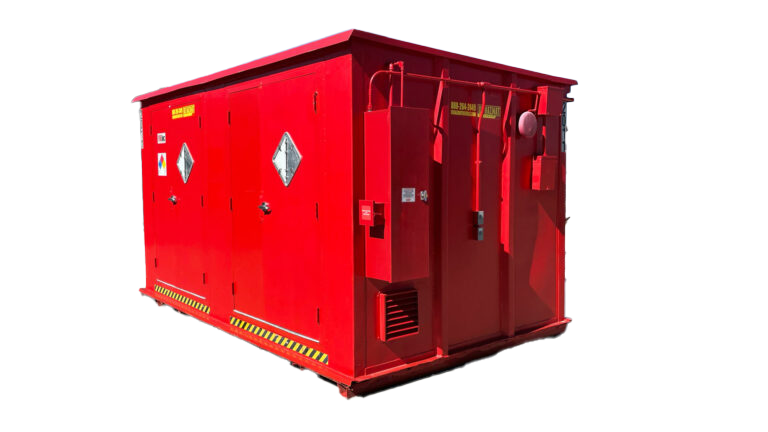Looking for compliant chemical storage, but weary of the costs? Investing in steel-welded chemical warehouses can prevent thousands of dollars in fines and unwarranted headaches for years to come. Everyday, dozens of manufacturing facilities find themselves on the receiving end of the judgmental pen from OSHA safety inspectors. Recurring hazmat fines can deprive operations of profit and good will in the community. Feeling governmental pressure like never before, two manufacturers will now face maximum OSHA penalties for not playing by the rules. As always, this hit to operational costs is completely preventable with turnkey storage protection from U.S. Hazmat Rentals.
DOT Increases Recurring Hazmat Fines

Citations for recurring hazmat fines carries a devastating reverberating effect for any manufacturer. In a stunning announcement, the DOT has announced increases to hazmat fines for shipping violations. Beginning last year, an $89,678 per day violation is the new maximum civil penalty for any hazmat shipping violation. But the bad news doesn’t end with a not-so-subtle slap on the wrist. A hefty $209,249 penalty is the new max fine for any violation that causes death, illness, severe injury or property damage. No one is immune from increasing governmental purview. Even everyday employees can be subject to fines. Last year, the DOT gave the greenlight for a new $540 per employee max penalty for failure to provide hazmat training as required by 49 CFR 172.704. As you can decipher from this complex government code book, a single penalty and recurring hazmat fines can more than provide the funds necessary for both short and long-term protection.
Worker Fatalities Result in Maximum OSHA Penalties
Need further evidence the government means business when it comes to worker safety? Looking to put the squeeze on chemical renegades, OSHA is handing down the maximum penalty following two separate incidents that led to worker fatalities. OSHA is ordering Chemical Products Corp. of Cartersville, Ga. to pay $55,403 in proposed penalties after a 52-year-old leach tank operator suffered fatal chemical and thermal burns over most of his body. OSHA alleges the company failed to establish proper lockout/tagout procedures, which led to the thermal and chemical hazards. Proper lockout/tagout practices protect workers from dangerous chemical releases. These practices also describe the processes necessary to disable dangerous machinery and equipment. The Georgia company is also facing fines for failing to “periodically inspect the energy control procedures, at least annually, while employees were tasked with applying lockout/tagout devices.” In addition, the company is dealing with severe reprimands for not providing readily available safety data sheets.
What Are Safety Data Sheets?

Safety Data Sheets have become the “black box” warning label of chemical storage. These condensed, yet precise sheets contain information relating to the properties of dangerous chemicals. Unique and separate SDS have become available for each volatile chemical compound. A SDS will also provide guidelines for the proper storage of each chemical, as well as what to do in the event of a chemical incident. Each SDS contains the melting and flash points for each chemical. For maximum protection, SDS should be readily available at the job site for each dangerous chemical that is held at your base of operations. Failing to provide a SDS, can result in hefty fines.
Georgia Chemical Plant Could Be Guilty of Recurring Fines
The leach tank operator that lost his life on the job had only been working at the facility for two months. OSHA claims he opened an air intake valve to inspect a noise in a pipe. Suddenly, a cold rush of air created a bubble that pushed back heated sludge onto the worker, causing fatal burns. Before finalizing its report, OSHA found that 25 days following the fatal release, another employee inspecting a gasket under a tank of sodium hydroxide also suffered chemical burns when the tank overflowed.
“Two serious incidents just weeks apart show that the culture at Chemical Products Corp. must change to emphasize worker safety and health. OSHA will continue to monitor and hold the company accountable until there are changes,” Jeffery Stawowy, OSHA’s Atlanta-West area office director, said in an agency statement.
www.safety.blr.com
Perhaps unsurprisingly, OSHA is announcing that it’s hazard communication standard remains its second most frequently cited violation. Recurring hazmat fines will always be the most preventable penalty form governing bodies. Once negligence is discovered, facilities’ managers should act quickly to alleviate the storage concern before another impromptu visit from OSHA. Investing in a fire-rated chemical storage locker from U.S. Hazmat Rentals is perfect for operations that need temporary storage without the long-term expenditure.
Concrete Contractor to Face Hefty OSHA Fine
In an unrelated case, but still carrying the full weight of faulty chemical storage practices, a Massachusetts’s concrete contractor is facing a $209,905 penalty following an accident that claimed the life of a soil screener. OSHA alleges the company instructed an employee to remove a soil screen from from a conveyor, which led to him being crushed between the conveyor and its frame. Going back to proper lockout procedures, OSHA claims failure to properly locking out the conveyor’s power source as the cause of death. In total, the company faces fines for six violations. According to the safety inspectors, the company didn’t have a proper lockout/tagout program in place to the prevent the worker’s death. They also claim the soil screener wasn’t properly maintained. Moreover, the company also faces penalties for allowing employees to ride in the front-end loader’s bucket, exposing them to dangerous crush and fall hazards.
“Employers must develop and rigorously maintain equipment and each element of their energy control plans to identify and minimize hazards and protect workers’ safety and health,” James Mulligan, OSHA’s Braintree, Massachusetts, area office director, said in a statement.







